
15 minute read
ELECTRICAL SYSTEM
Description
Figure182
The excavator has a 12 volt, negative earth electrical system. The electrical system is protected by fuses located under the right side cover of the excavator (Item 1) [Figure182]. The fuses will protect the electrical system when there is an electrical overload. The reason for the overload must be found and corrected before starting the engine again.
The battery cables must be clean and tight. Check the electrolyte level in the battery. Add distilled water as needed. Remove acid or corrosion from the battery and cables with a sodium bicarbonate and water solution.
Put Battery Saver P/N 6664458 or grease on the battery terminals and cable ends to prevent corrosion.
Warning
AVOID INJURY OR DEATH
Batteries contain acid which burns eyes and skin on contact. Wear goggles, protective clothing and rubber gloves to keep acid off body.
In case of acid contact, wash immediately with water. In case of eye contact get prompt medical attention and wash eye with clean, cool water for at least 15 minutes.
If electrolyte is taken internally drink large quantities of water or milk! DO NOT induce vomiting. Get prompt medical attention.
W-2065-0807
Fuse And Relay Location / Identification
A decal is inside the fuse cover to show location and amp ratings.
Remove the cover to check or replace the fuses and relays.
The location and amperage ratings are shown in [Figure 183]
Always replace fuses using the same type and capacity.
ELECTRICAL SYSTEM (CONT’D)
Fuse And Relay Location / Identification (Cont’d)
Figure 183

The location and amperage ratings are shown in the table below and on the decal [Figure 183]. Relays are identified by the letter “R” in the AMP column.
ELECTRICAL SYSTEM (CONT’D)
Shutoff Switch


Open the right side cover. (See Opening And Closing on page105.)
Figure184
The shutoff switch (Item 1) [Figure184] is located in the right side cover below the fuse panel
Rotate the switch (Item 1) [Figure184] anticlockwise to turn the switch to the OFF position, clockwise to ON position.
Battery Maintenance
Open the right side cover. (See Opening And Closing on page105.)
Figure185
The battery (Item 1) [Figure185] is located in the front of the right side upperstructure.
The battery cables must be clean and tight [Figure186] Remove acid or corrosion from the battery and cables using a sodium bicarbonate and water solution. Cover the battery terminals and cable ends with battery saver grease to prevent corrosion.

Check for broken or loose connections.
If the battery cables are to be removed for any reason, disconnect the negative (-) cable first. When installing the battery cables, make the last connection the negative (-) cable to the battery.
The original equipment battery is maintenance free. If a replacement battery is installed, check the electrolyte level in the battery.

If the electrolyte level is lower than 13 mm (0.50 in) above the plates, add distilled water only.
Warning
AVOID INJURY OR DEATH
Batteries contain acid which burns eyes and skin on contact. Wear goggles, protective clothing and rubber gloves to keep acid off body.
In case of acid contact, wash immediately with water. In case of eye contact get prompt medical attention and wash eye with clean, cool water for at least 15 minutes.
If electrolyte is taken internally drink large quantities of water or milk! DO NOT induce vomiting. Get prompt medical attention.
W-2065-0807
ELECTRICAL SYSTEM (CONT’D)
Using A Booster Battery (Jump Starting)
Important
If jump starting the excavator from a second machine:
When jump starting the excavator from a battery installed in a second machine, make sure the engine is NOT running while using the glow plugs. High voltage spikes from a running machine can burn out the glow plugs.
I-2060-0906
If it is necessary to use a booster battery to start the engine, BE CAREFUL! There must be one person in the operator’s seat and one person to connect and disconnect the battery cables.
Be sure the key switch is OFF. The booster battery must be 12 volt.
Open the tailgate. (See Opening And Closing on page104.)
NOTE:(See Cold Temperature Starting on Page 70.)
Important
Damage to the alternator can occur if:

•Engine is operated with battery cables disconnected.
•Battery cables are connected when using a fast charger or when welding on the excavator. (Remove both cables from the battery.)
•Extra battery cables (booster cables) are connected wrong.
I-2223-0903
Warning
AVOID INJURY OR DEATH
Batteries contain acid which burns eyes and skin on contact. Wear goggles, protective clothing and rubber gloves to keep acid off body.
In case of acid contact, wash immediately with water. In case of eye contact get prompt medical attention and wash eye with clean, cool water for at least 15 minutes.
If electrolyte is taken internally drink large quantities of water or milk! DO NOT induce vomiting. Get prompt medical attention.
W-2065-0807
Connect one end of the first cable to the positive (+) terminal of the booster battery. Connect the other end of the same cable to the positive (+) terminal (Item 1) [Figure187] of the excavator starter.
Connect one end of the second cable to the negative (-) terminal of the booster battery. Connect the other end of the starter mounting bolt (Item 2) [Figure187]
Start the engine. After the engine has started, remove the earth (-) cable first (Item 2) [Figure187]
Disconnect the cable from the excavator starter (Item 1) [Figure187].
ELECTRICAL SYSTEM (CONT’D)
Removing And Installing The Battery
Open the right side cover. (See Opening And Closing on page105.)
Remove the right side panel.
Figure188
Warning
Avoid Injury Or Death
Batteries contain acid which burns eyes and skin on contact. Wear goggles, protective clothing and rubber gloves to keep acid off body.
In case of acid contact, wash immediately with water. In case of eye contact get prompt medical attention and wash eye with clean, cool water for at least 15 minutes.
If electrolyte is taken internally drink large quantities of water or milk! DO NOT induce vomiting. Get prompt medical attention.
Disconnect the negative (-) cable (Item 1) [Figure188] first.
Disconnect the positive (+) cable (Item 2) [Figure188]
Remove the bolt (Item 3) [Figure188] and remove the hold down clamp.
Remove the battery.
Always clean the terminals and the cable ends, even when installing a new battery.
Install the battery. Install the hold down clamp and tighten the bolts.

Connect the battery cables. Connect the negative (-) cable (Item 1) [Figure188] last to prevent sparks.
Tighten the terminal clamp nuts to 7 N•m (5 ft-lb) torque.
Hydraulic System
Checking And Adding Hydraulic Fluid
Put the machine on a flat level surface.
Retract the arm and bucket cylinders, put the bucket on the ground and lower the blade. Stop the engine.

Open the right side cover. (See Opening And Closing on page105.)
Warning
Avoid Injury Or Death
Always clean up spilled fuel or oil. Keep heat, flames, sparks or lighted tobacco away from fuel and oil. Failure to use care around combustibles can cause explosion or fire.
W-2103-0508
Park the machine in the position shown [Figure189] (The preferred method is to check the hydraulic fluid when it is cold.)
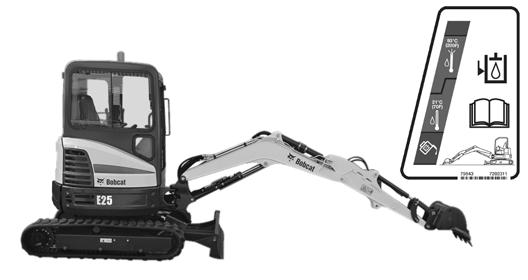
Check the hydraulic fluid level, it must be visible in the sight gauge (Item 1) [Figure189]. The decal on the hydraulic tank shows the correct fill level.

A - Correct Oil Level COLD (Preferred)
B - Correct Oil Level HOT (Optional)
Clean the surface around the reservoir cap and remove the cap from the reservoir (Item 2) [Figure189]
Check the condition of the fill strainer screen (Item 1) [Figure190]. Clean or replace as necessary.
Be sure the screen is installed in the tank before adding fluid.
Add the correct fluid to the reservoir until it is visible in the sight gauge. (See LUBRICANTS AND FLUIDS on Page 10.)
Check the cap and clean as necessary. Replace the cap if damaged. Install the cap. Close the right side cover and tailgate.
HYDRAULIC SYSTEM (CONT’D)
Hydraulic / Hydrostatic Fluid Chart
Figure191
HYDRAULIC / HYDROSTATIC FLUID RECOMMENDED ISO VISCOSITY GRADE (VG) AND VISCOSITY INDEX (VI)
Removing And Replacing The Hydraulic Filters
Warning
AVOID INJURY OR DEATH
Always clean up spilled fuel or oil. Keep heat, flames, sparks or lighted tobacco away from fuel and oil. Failure to use care around combustibles can cause explosion or fire.
Hydraulic Filter
See the service schedule for the correct service interval. (See SERVICE SCHEDULE on Page 99.)
Figure192

TEMPERATURE RANGE ANTICIPATED DURING MACHINE USE
[1] VG 100; Minimum VI 130
[2] VG 46; Minimum VI 150
[3] BOBCAT All-Season Fluid
[4] BOBCAT Synthetic Fluid
[5] BOBCAT Biodegradable Hydraulic / Hydrostatic Fluid (Unlike biodegradable fluids that are vegetable based, Bobcat biodegradable fluid is formulated to prevent oxidation and thermal breakdown at operating temperatures.)

Install the oil fill cap.
For easier access to change the hydraulic filter, remove the lower right side panel.
Remove the four bolts (Item 1) and the side panel (Item 2) [Figure192]. Remove the side panel.
Open the right side cover. (See Opening And Closing on page105.)
HYDRAULIC SYSTEM (CONT’D)
Removing And Replacing The Hydraulic Filters (Cont’d)
Figure193
Remove the hydraulic filter (Item 1) [Figure193]
Clean the housing where the filter gasket makes contact.
Put clean hydraulic fluid on the gasket. Install the new filter and hand tighten only. Use a genuine Bobcat replacement filter.
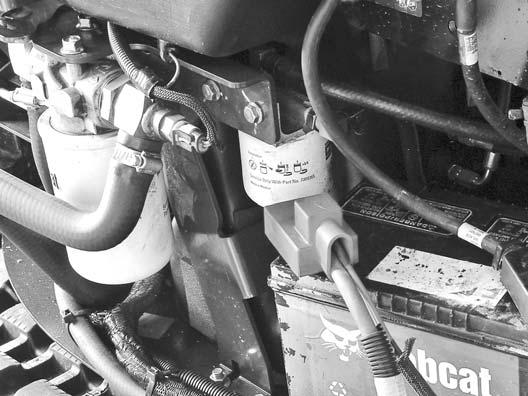

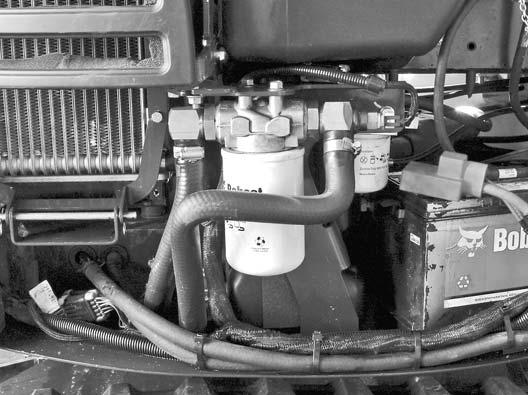
Warning
AVOID INJURY OR DEATH
Always clean up spilled fuel or oil. Keep heat, flames, sparks or lighted tobacco away from fuel and oil. Failure to use care around combustibles can cause explosion or fire.
W-2103-0508
Case Drain Filter
See the service schedule for the correct service interval. (See SERVICE SCHEDULE on Page 99.)
For easier access to change the case drain filter, remove the lower right side panel.
Figure194
Remove the four bolts (Item 1) and the side panel (Item 2) [Figure194]. Remove the side panel.
Open the right side cover. (See Opening And Closing on Page 105.)
Figure195
Remove the case drain filter (Item 1) [Figure195]
Clean the housing where the filter gasket makes contact.
Put clean hydraulic fluid on the gasket. Install the new filter and hand tighten only.
HYDRAULIC SYSTEM (CONT’D)
Removing And Replacing The Hydraulic Fluid
See the service schedule for the correct service interval. (See SERVICE SCHEDULE on Page 99.)
Warning
Avoid Injury Or Death
Diesel fuel or hydraulic fluid under pressure can penetrate skin or eyes, causing serious injury or death. Fluid leaks under pressure may not be visible. Use a piece of cardboard or wood to find leaks. Do not use your bare hand. Wear safety goggles. If fluid enters skin or eyes, get immediate medical attention from a doctor familiar with this injury.
W-2072-EN-0909
Retract the arm and bucket cylinders, lower the bucket to the ground. Stop the engine.
Open the tailgate. (See Opening And Closing on Page 104.)
With the engine OFF, loosen the plug (Item 1) [Figure197] on the hydraulic pump. Tighten the plug after a steady stream of hydraulic fluid, free of any air bubbles, drains from the plug. DO NOT RUN THE MACHINE WITH THE PLUG OPEN.


The hydraulic fluid drain plug (Item 1) [Figure196] is located below right side of the upperstructure.
Remove the plug (Item 1) [Figure196]
Drain the fluid into a container.
Recycle or dispose of the fluid in an environmentally safe manner.
Install the plug (Item 1) [Figure196].
Add fluid to the reservoir. (See Checking And Adding Hydraulic Fluid on Page 123.)
There is also a port (Item 1) [Figure198] on the hydraulic cooler for bleeding air. Install a diagnostic coupler and hose on this fitting to allow air to be bled from the hydraulic system after the hydraulic fluid has been replaced.
Start the engine and operate the machine through the hydraulic functions. Stop the engine. Check the fluid level and add as needed.

TRACK TENSION
Checking Tension
NOTE:The wear of the pins and bushings on the undercarriage vary with the working conditions and the different types of soil conditions. It is necessary to inspect track tension and maintain the correct tension. See service schedule for the correct service interval. (See SERVICE SCHEDULE on Page 99.)
Raise the side of the machine (approximately 102 mm [4 in]) using the boom and arm.
Warning
AVOID INJURY
Keep fingers and hands out of pinch points when checking the track tension.
W-2142-0903
Rubber Track Clearance
Figure201
10 - 15 mm
(0.39 - 0.59 in)
10 - 15 mm
(0.39 - 0.59 in)
P-97652
Track Frame
Rubber
Track
P-97651
Raise the blade fully and install jackstands under the blade and track frame (Item 1) [Figure199] and [Figure200]. Raise the boom until all machine weight is on the jackstands.

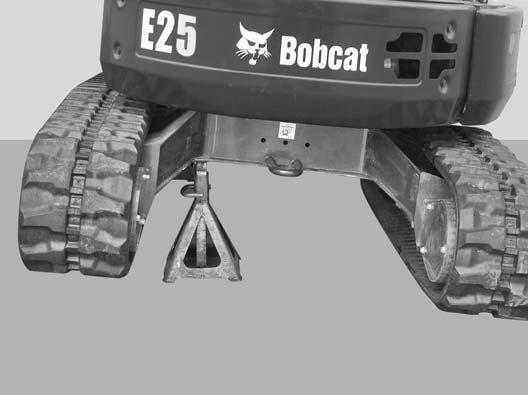
Stop the engine.
B-14067
Measure the clearance at the middle track roller. Do not get fingers into pinch points between the track and the track roller. Use a bolt or a dowel of the appropriate size to check the gap between the contact edge of the roller and the top edge of the track guide [Figure201] and [Figure202]

Track Clearance10 - 15 mm
(0.39 - 0.59 in)
TRACK TENSION (CONT’D)
Adjusting Tension
Figure203
Loosen the two access cover bolts and pivot the access cover down [Figure203].

Increase Track Tension
Add grease to the fitting (Item 1) [Figure203] until the track tension is correct.
Decrease Track Tension
Warning
AVOID INJURY OR DEATH
If grease fitting is removed before pressure is released, the fitting can come off with great force and cause serious injury or death.
W-2490-0104
Pressure must be released from the grease cylinder to decrease track tension.
Loosen the bleed fitting (Item 2) [Figure203], (NOT the grease fitting (Item 1) [Figure203], and release pressure until the track tension is correct.
NOTE:DO NOT loosen the bleed fitting (Item 2) [Figure203] for more than eight turns.
Tighten the bleed fitting to 80 - 100 N•m (59 - 74 ft-lb) torque.
Pivot the access cover up and tighten the two access cover bolts.
Raise the machine and remove the jackstands.
Repeat the procedure for the other side.
Dispose of grease in an environmentally safe manner.
Travel Motor
Checking And Adding Oil
Figure204
Park the excavator on a level surface with the plugs (Items 1 and 2) [Figure204] in the vertical position as shown.
Remove the plug (Item 1) [Figure204]. The lube level must be at the bottom edge of the hole.
Add lubricant (SAE 90W) through the hole if the lube level is low.
Removing And Replacing Oil
See the service schedule for the correct service interval. (See SERVICE SCHEDULE on Page 99.)
Park the excavator on a level surface with plugs (Items 1 and 2) [Figure204] in the vertical position shown. Remove both plugs and drain the lubricant into a container.

Warning
Avoid Injury Or Death
Always clean up spilled fuel or oil. Keep heat, flames, sparks or lighted tobacco away from fuel and oil. Failure to use care around combustibles can cause explosion or fire.
Install the bottom plug (Item 2) [Figure204]. Add lubricant through the centre plug hole until the lube level is at the bottom edge of the hole.
Install the plug (Item 1) [Figure204]
Alternator And Fan Belt

Belt Adjustment
The alternator and fan belt is a special maintenance free type that is pretensioned over the pulleys. This belt eliminates the need for a tensioning procedure and does not require periodic adjustment. Contact your Bobcat dealer for replacement parts.


Belt Replacement
Stop the engine and open the tailgate. (See Opening And Closing on page104.)
The flywheel will need to be rotated by hand to remove the belt. To access the flywheel, remove the plug (Item 1) [Figure207] from the flywheel housing.
Remove belt shield mounting nuts and bolts (Item 1) and remove the belt shield (Item 2) [Figure205]
Remove the two bolts (Item 3) and the coolant recovery tank (Item 4) [Figure205].

Loosen the bolt (Item 1), the lower alternator mounting bolt (Item 2) and nut (Item 3) [Figure206]
Use a pry bar to take the pressure off of the bolt (Item 1) [Figure206] and remove the top bolt.
ALTERNATOR AND FAN BELT (CONT’D)

Belt Replacement (Cont’d)
Figure209
Install a second pry bar (Item 1) [Figure209] or flat blade screw driver between the belt and the crankshaft pulley.
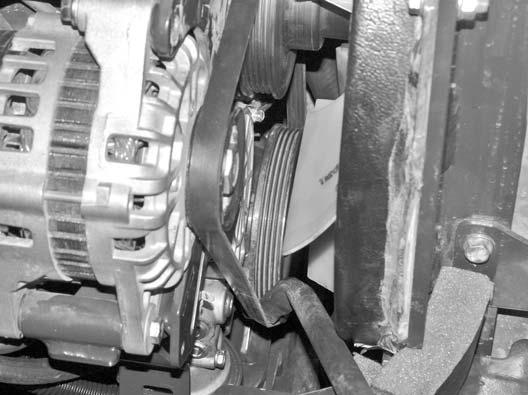

Using the pry bar (Item 1) [Figure208] to rotate the flywheel, start to push the belt off the pulley using the second pry bar (Item 1) [Figure209]
Continue to manually rotate the flywheel until the belt is removed from the pulley.
The belt shield (Item 2) [Figure209] will need to be worked over the fan blades until it can be removed.
NOTE:Fan blades can be sharp, use care when removing the belt over the fan blades.
Install the new alternator / fan belt.
Using the pry bar (Item 1) [Figure208] to rotate the flywheel and push the belt onto the pulley using the second pry bar (Item 1) [Figure210].
Continue rotating the flywheel until the belt is fully installed.
Install the flywheel plug (Item 1) [Figure207]
Figure211
Position the belt over the crankshaft pulley and next to the engine block and align the upper part of the belt to the water pump pulley and the alternator pulley.

Use the pry bar to position the alternator and install the bolt (Item 1) [Figure211] and tighten.
Tighten the alternator mounting bolt (Item 2) and the nut (Item 3) [Figure211]
Install the coolant recovery tank (Item 1) with the two bolts (Item 2) [Figure212]
Install the belt shield (Item 3) with the two bolts (Item 4) [Figure212] and nuts.
Close the tailgate.
X-CHANGE™
Inspection And Maintenance
Figure213
Inspect the attachment coupler for wear or damage. Inspect the coupler pins (Item 1) and the hooks (Item 2) [Figure213] (on the attachment) for wear or damage.
Repair or replace damaged parts.
TRACK ROLLER AND IDLER LUBRICATION Procedure
The track rollers and idlers require no maintenance. The bearings are a sealed design.
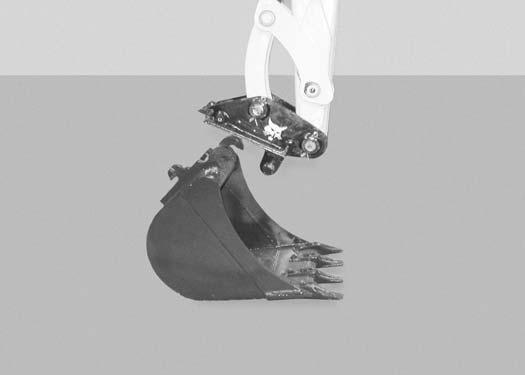
Bucket Teeth Removal And Installation
Warning
Wear safety glasses to prevent eye injury when any of the following conditions exist:
•Pressurised fluids and springs or other stored energy components.
•Flying debris or loose material is present.
•Engine is running.
•Tools are being used.
W-2505-EN-1009
Position the bucket so the bucket teeth are at a 30° angle up from the ground for accessibility to the teeth.
Lower the boom until the bucket is fully on the ground.
Stop the engine and exit the excavator.
The retaining pin (Item 1) must be installed as shown (notch [Item 2] to the front) for proper fit and tooth retention. The side of the tooth point (Item 3) [Figure214] also shows the correct orientation of the retaining pin.
Installation: Position the new tooth point on the shank and install a new retaining pin. Install the retaining pin until it is flush with the top of the point.

LUBRICATION OF THE HYDRAULIC EXCAVATOR
Lubrication Locations
Lubricate the excavator as specified in the service schedule for the best performance of the machine. (See SERVICE SCHEDULE on Page 99.)

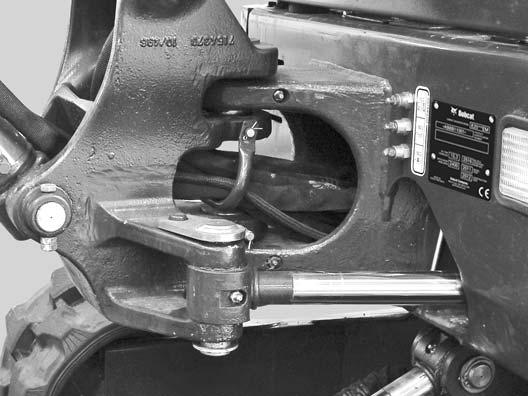
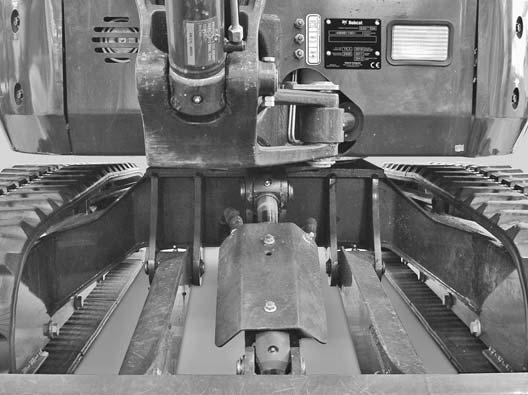
Always use a good quality lithium based multipurpose grease when lubricating the machine. Apply the lubricant until extra grease shows.
Lubricate the following locations on the excavator EVERY 8 - 10 HOURS:
LUBRICATION OF THE HYDRAULIC EXCAVATOR (CONT’D)



Lubrication Locations (Cont’d)

LUBRICATION OF THE HYDRAULIC EXCAVATOR (CONT’D)
Lubrication Locations (Cont’d)
Figure222
13.Bucket Cylinder Rod End (1) [Figure222]
14.Bucket Link Pin (1) [Figure222].
15.Bucket Pivot (1) [Figure222]
16.Bucket Link (3) [Figure222].
Figure 223
17.Boom Swing Cylinder Base (1) [Figure 223].
Lubricate the following locations on the hydraulic excavator EVERY 50 HOURS:

18.Slew Circle (1) [Figure 223]
19.Slew Pinion (1) [Figure 223]. (Install three to four pumps of grease then rotate the upperstructure 90°. Install three to four pumps of grease and again rotate the upperstructure 90°. Repeat this until the slew pinion has been greased at four positions.)

PIVOT PINS Inspection And Maintenance
Figure 224
The pivots and cylinders (Item 1) have a large pin held in position with a bolt (Item 2) and double nuts (Item 3) [Figure 224] securing the pin.
The two nuts (Item 3) are used as jam nuts to hold the bolt (Item 2) without tightening the bolt (Item 2) to the pin boss. After the nuts (Item 3) are tightened together, the bolt (Item 2) [Figure 224] should be free to spin. See your Bobcat dealer for replacement parts.

EXCAVATOR STORAGE AND RETURN TO SERVICE Storage
Sometimes it may be necessary to store your Bobcat excavator for an extend period of time. Below is a list of items to perform before storage.
•Thoroughly clean the excavator including the engine compartment.
•Lubricate the excavator.
•Replace worn or damaged parts.
•Drive the excavator onto planks in a dry protected shelter.
•Lower the boom fully with the bucket flat on the ground.
•Put grease on any exposed cylinder rods.
•Put fuel stabiliser in the fuel tank and run the engine a few minutes to circulate the stabiliser to the pump and fuel injectors.
•Drain and flush the cooling system. Refill with premixed coolant.
•Replace all fluids and filters (engine, hydraulic).
•Replace all filters (For example: air cleaner, heater, etc.).
•Put all controls in neutral position.
•Remove the battery. Be sure the electrolyte level is correct then charge the battery. Store it in a cool dry place above freezing temperatures and charge it periodically during storage.
•Cover the exhaust pipe opening.
•Tag the machine to indicate that it is in storage condition.
Return To Service
After the Bobcat excavator has been in storage, it is necessary to follow a list of items to return the excavator to service.
•Check the engine and hydraulic fluid levels; check coolant level.
•Install a fully charged battery.
•Remove grease from exposed cylinder rods.
•Check all belt tensions.
•Be sure all shields and guards are in place.
•Lubricate the excavator.
•Remove cover from exhaust pipe opening.
•Start the engine and let run for a few minutes while observing the instrument panels and systems for correct operation.
•Drive the excavator off of the planks.
•Operate machine, check for correct function.
•Stop the engine and check for leaks. Repair as needed.











